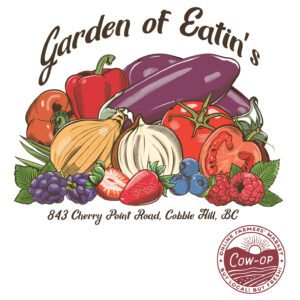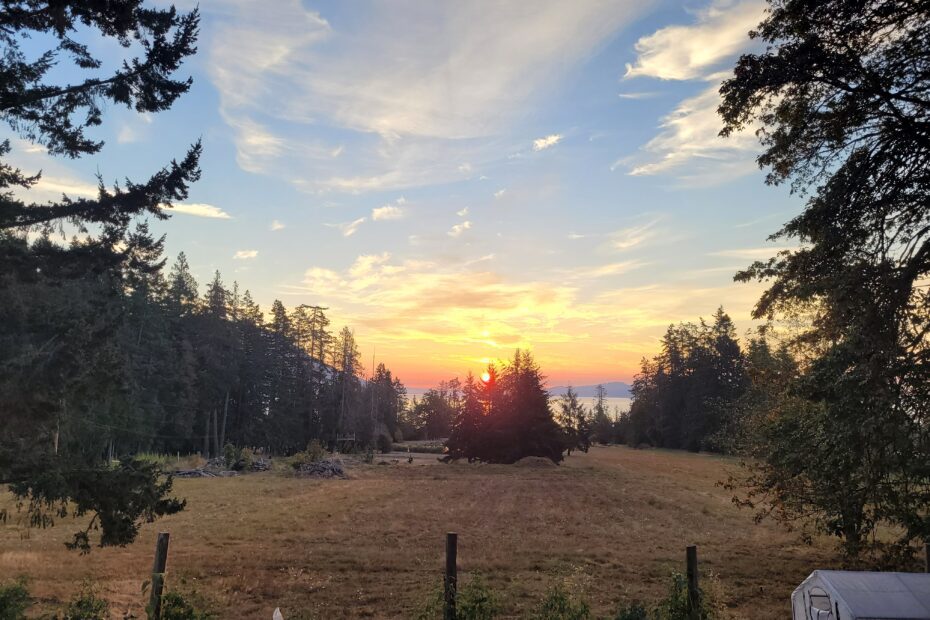
We moved just over a year ago (2021) to a two-acre on ALR (Agricultural Land Reserve) property with a view of the water in the distance.
The property has a well, and magnificent sun exposure. There are tall trees on the land, many old tree stumps with huckleberries, and enough rocks to build a fortress.
Short-term goals are to produce a significant proportion of our own food, and enough to benefit those in the community who are food insecure. Long-term goals for the property are to plant a vineyard to explore trellising / varietal options for the region, and to develop a viable farm that supports us without back-breaking labour. There will be chickens and goats.
Fortunately, we are not high-maintenance…unless you calculate the effort involved in producing culinary art…but that is more fun than work and the effort is part of the reward.
We moved here in July of 2021, bringing plants in large pots to complete their growing cycle. There were perhaps 20 tomato plants, 6 or 7 peppers, strawberries, raspberries, asparagus, peas, and some herbs. A bit of this and that in addition, but those were the main things. Most of it survived the move nicely and there were minimal casualties.
Considering that nothing made it into the ground, we grew a generous amount of tomatoes. The last of the sauce from 2021 was used up in May 2022, except for a hidden container discovered in late September.
In 2023, there were 22 varieties, and over 60 tomato plants, of which 15 or so are 3 dwarf varieties. My favourite of the dwarfs in 2023 was Black Sea Man, a 2′ spindly plant that grows 4″-5″ beefsteak tomatoes. In 2024, there are 55 varieties,with many more dwarfs and some micro-dwarfs. Not sure how many tomato plants I will grow this year, as there is also a large list of other vegetable and herbs planned. There would have been more last year, but varmints ate many of the seedlings and a windstorm tossed the replacements onto the roof.
The soil is shallow and loamy, and needs to be supplemented with raised beds to grow some of the produce we depend on. This first year has been spent building / planting raised beds and removing rocks and boulders, as well as propagating plants in makeshift “greenhouses” that are little more than cold frames with heating pads.
We plan to build some hoop houses to get some of the potted peppers and tomatoes through the winter (fingers crossed), as some of the more interesting peppers need to be at least 10 months old to produce. Planning to build at least one hoop house using a pallet garden as the base.
Our ever-expanding collection of the aforementioned rocks and boulders is piled in an area dubbed “The Rock Garden” because it grows so quickly. Some are already in service elsewhere, defining the boundaries of garden beds.
As virtually the entire property is on a hill, we plan to use these rocks and some available slash-pile wood to build terraces both in front and back of the house. This will help us in making the property safer and more pleasant to walk around in the mornings…and not incidentally, will make it easier to age here.
Sometimes removal isn’t the proper solution to a hazard. In one case, we had a bad tripping hazard that revealed itself to be a stump with a massive protruding root attached to it. A powerful tractor that we have access to is more than sufficient to the task. We were not sure however what kind of a hole this might create and how much labour would be required to deal with the hole.
Instead, we treated the formation like a berm, planting it with 5 blueberry bushes, and a selection of red and pink pansies as ground cover.
The past 14 months have been a massive project of weed suppression and moving soil. The fence dividing the property we live on from the neighbours
I would have liked to begin by using cardboard to hold back the weeds, but quantities of cardboard take time to assemble. A friend suggested a local palette company that leaves the tarp that covers the wood they build from out at the road for whoever wants it to take away.
This turned out to be a great tip. It gave us time to get things started and begin determine what works best where. While it was a lot of work to move the established beds, at least it was fast putting them in at the time, and we got it done in time for the season. That worked well in the first two years, but as it wasn’t meant to be permanent. I have spent the past few months digging up the beds and removing the tarp, while also moving the second row a foot or so further from the first.
Now, we are beginning to harvest tomatoes in earnest. It should have begun over a month ago, but the season has been challenging with the unpredictable patterns of climate change.
I had expected at least twice what we will end up harvesting. So far, we have about 52lbs of tomatoes, and expect between 2 nd 3 bushels more. Peppers are beginning to come and lettuce is abundant because we used it as ground cover.
I would say that we are nearly done for the season, but the climate here allows for year round growing. There may be a few weeks when the cold kills off most of the crops, but “winter vegetables” are a big deal here, so we have some cauliflower, brussels sprouts, and broccoli planted. And of course, it’s time to lay in garlic for next year. We have 250 cloves planted so far, with hopes of getting another 250 in.
It wasn’t a great beginning, but, things still came out okay for a first exploratory year. We are very excited about how next year will unfold and looking forward to making and watching it happen.
